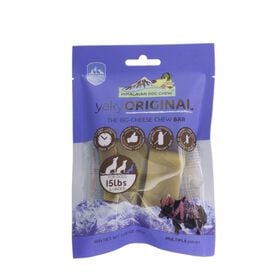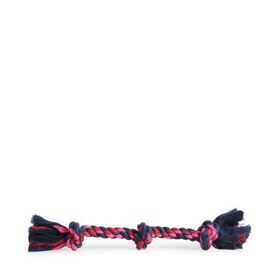
The Lhasa apso: partner of Tibetan monks
Published October 20, 2021.

Jean-Christophe Boulinguez
Canadian Kennel Club Conformation Judge
In its country of origin in Tibet, the Lhasa apso is commonly called Apso Seng Kyi, which translates as "bearded lion dog." The Lhasa apso was used primarily as a guard dog, protecting the homes of Tibetan nobility and Buddhist monasteries, specifically those near the holy city of Lhasa.
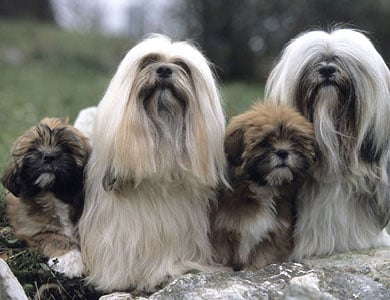
Physical appearance
The Lhasa apso's sturdy, well-balanced appearance makes it a very attractive breed. The Lhasa apso is a small dog, longer than it is tall, that is between 25 and 28 cm (10 and 11 in.) at the withers. Females are generally a bit smaller. On average, they weigh 5 to 8 kg (12 to 18 lbs). The Lhasa apso has an abundant topcoat that is long, straight, coarse, neither woolly nor silky, and dense all over the body, head and paws, with an undercoat. When kept long, the coat is parted in the middle from head to tail. All coat colours are accepted, including shades of beige or grey, and black or white. The coat can also be parti-coloured (several distinct colours at once).
The muzzle is of fair length, approximately 4 cm (1½ in.) long, with the length from tip of the nose to eye being roughly one-third the total length of the head. The eyes are dark brown and almond-shaped. Full depth of dark pigmentation on eye rims and lips is essential.
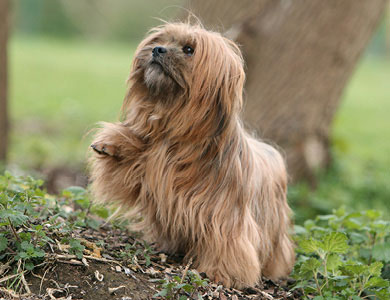
Life expectancy and health
The Lhasa apso is a very healthy, sturdy and ancient breed, with a long average lifespan of 12 to 15 years. It is not immune to some of the health problems that occur over a dog's lifetime. The most serious health issue affecting the breed is hereditary kidney dysfunction, which can be mild to severe. Other issues sometimes seen in Lhasa apsos are pigmentary keratitis, glaucoma, hemorrhagic gastroenteritis and patella luxation.
Energy level and temperament
Lhasa apsos are generally not lazy dogs, and like to get exercise. They can often be found running around in the house to expend energy, and would be happy to have a fenced-in yard or to go for brisk walks with their owners. Mental stimulation is just as important as physical exercise, and the breed excels at agility training.
This very intelligent breed is sometimes compared to a slightly stubborn child. It has a very unique personality and, since it is protective of its owner, it does not respond well to having its owner threatened. It is an excellent guard dog that barks only in unusual situations.
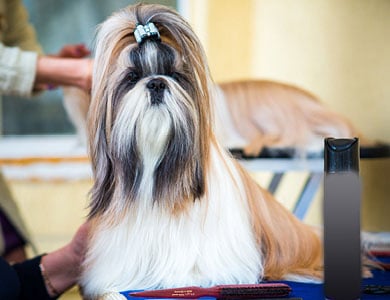
Maintenance and grooming
The Lhasa apso is a high-maintenance breed. It must be brushed often, ideally two or three times a week, even if its coat is trimmed. A regular bath at least once a month (or more, if necessary) is required to keep its coat looking healthy and at its best. The breed does not shed much, but the thicker puppy coat will tend to shed during grooming until approximately age 2. The hair between the paw pads must be trimmed often to avoid becoming matted and causing the dog to slide on the floor. As with all breeds, nails should be clipped regularly, at least once a month. In addition, ears and eyes should be checked and cleaned regularly.
Origins
The Lhasa apso is one of the oldest breed of dogs in the world. Having originated approximately 2,800 years ago at the heart of the Tibetan plateau, North of the Himalayas, it is believed that the breed resulted from crossing the Tibetan spaniel, which is small and does not have very long hair, with the Tibetan terrier, which is much larger and has hair similar in length to the Lhasa apso. Research conducted in the early 2000s shows that, from a genetic standpoint, the Lhasa apso is one of the breeds most closely related to the wolf.
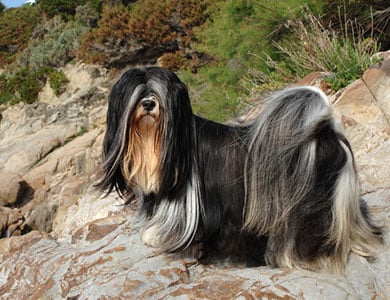
Large Tibetan mastiffs guarded entrances to monasteries, but the Lhasa apso's acute hearing and sharp barks warned residents when an intruder managed to get past the outside sentries. These small guard dogs were highly prized by Buddhist monks and the wealthy. It was also believed that they were temporary vessels for the souls of deceased Dalai-Lamas who were waiting to be reborn as humans. In Tibet, Lhasa apsos were never sold. They could only be obtained as gifts.
In the early 20th century, Colonel Bailey, a British military attaché in Tibet at the time, was given a couple of Lhasa apsos, which produced five puppies. In 1928, he brought them back to England and bred the first Lhasa apsos in Great Britain. In Canada, the breed was first registered in 1934. Although they may have been imported to Canada before the 1930s, two Lhasa apsos from Shanghai were the first to be documented. Imported by Margaret Torrible of Vancouver in 1931, they were the first of the breed to be registered in Canada. In 1973, Club Lhasa Apso du Québec became Lhasa Apso Canada, which is now the country's official breed club.
For more information, contact a registered breeder at the Canadian Kennel Club, who can answer all your questions. You can also contact the organization for information on breeders and the various breed clubs in Quebec and elsewhere in Canada.
